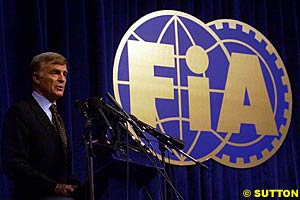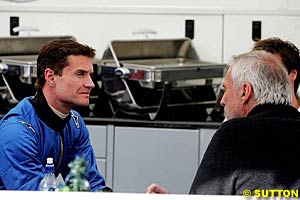Atlas F1 Magazine Writer
Fresh from the Formula One paddock
The first FIA Formula One World Championship season, in 1950, listed six Grands Prix – Great Britain, Monaco, Switzerland, Belgium, France, and Italy - plus the anomalous Indianapolis 500. All, bar the Brickyard's race, were European-based.
Ten years later the tally was 10. Indy was still in – for the final time, as it transpired – with races added in Argentina, Holland and Sebring, USA and Portugal. Switzerland, though, dropped out after its law makers banned motorsport in the wake of the 1955 Le Mans disaster. Tellingly, the Championship had spread to three continents.
By 1980 Argentina was back in, run alongside neighbour Brazil; South Africa maintained its fixture, with Watkins joined by a race in Long Beach, California. Result: 14 Grands Prix on four continents. A decade on, fans saw 16 races on five continents, plus in the Eastern Bloc with Hungary's Grand Prix. South Africa had fallen by the wayside, first temporarily, then seemingly permanently despite recent noises to the contrary; though Australia and Japan joined the fray.
And so calendar expansion had gone. In 1997, though, with the signing of the latest Concorde Agreement, the race list was capped at 17 events, and, in fact, Clause 14 of the 2005 Formula One Sporting Regulations stipulates that as maximum number, with eight races being the lowest.
But, come this year, the number was up to 18 after Bernie Ecclestone cut pretty shrewd deals with the Canadian promoters and all ten competing teams; Bahrain and China, then, hosted rounds on some seriously spectacular circuits in rather unusual surroundings. 2005, of course, sees the Championship contested over 19 races after the addition of Turkey, and now suggestions have the 2006 calendar at 20, or even more, races.
In October, a seven-year contract between Ecclestone's companies and Mexico authorities for a race in the resort region of Cancun was announced, and, with all the recent renewals and extensions of existing contracts, a race calendar containing at least 20 events seems certain for 2006. If South Africa's optimism is factored in, and rumours that Egypt, Dubai and Qatar are strong punters taken seriously, the figure could readily grow to 22 or even more, with all six inhabited continents represented.
All this is, of course, financial manna for Ecclestone, plus administrative bliss for FIA President Max Mosley: the greater the number of Grands Prix, the less the opportunities for testing between events particularly if the tendency for back-to-back races increases commensurately. And, guess who controls that aspect?
It all means, though, that teams will come under increasing work pressures, with, as always, the minnows suffering the most. The likes of Ferrari, McLaren and Toyota operate enormous test operations, so could, with relatively little disruption, switch staff between ever-busier race crews and slackening test teams. Jordan, Minardi and Red Bull, though, have no such fat, so will feel the effects throughout each season.
Downside, apart from the effect on teams and Formula One personnel, that is? At some point F1 will hit natural viewer saturation, and it was Mosley himself who, when asked four years ago about a possible increase to 20 races, said too many races would decrease world-wide interest. Why should the same not hold true in 2006?
After the initial euphoria, have post-purchase blues hit home at Red Bull? First mixed messages regarding their 2005 driver line-up have emanated from the team, with a senior team member suggesting that the choice of David Coulthard as team leader was 'a no-brainer', another team member telling sources that a deal had been done, whilst still another being adamant that the team would choose youth over experience.
All the while Red Bull Racing denied that Coulthard was under serious consideration, then, after his distinctive motorhome was spotted inside Jerez, put out a rather terse release confirming that he would be testing, but that no further comments would be made.
But, as we stated before, drivers are the least of the team's immediate concerns, and of greater priority is the reorganisation of an outfit which slumped in both the morale and technical spheres; one that last year, when matters were at their most crucial, saw their boss formulating rather fanciful qualifying formats. "Like re-arranging the deck chairs on the Titanic as she slides down," as one a team insider put it.
Now, though, comes news of rather more serious matters which could affect the entire marketing thrust of the team and their activities in France. Today, Wednesday, the EU's highest court, the European Court of Justice, found against European Commission appeals that sought to overturn a French government ban on the sale of Red Bull after studies by French Scientific Committee on Human Nutrition showed it contained excessive quantities of caffeine and other 'kick-starting' substances.
The judge found that, while some toxicology experts concluded that caffeine levels in Red Bull are safe, France had a right to ban the drink on the advice of its own experts, meaning the product may not be sold in France. (Its sale is also banned in Denmark).
Whether the French end up banning logos of the striking head-bashing bulls during Grand Prix weekends is another question, but, forget not, it was Evian's Law, stemming from France, which first banned promotion of tobacco and alcohol products in the EU. Matters progressed from there, leading to Formula One cars in France and elsewhere carrying 'coded' messages or lavishly-scripted driver names in place of cigarette logos. The next step was engineering a total ban on tobacco marketing throughout the EU, to be enforced from end-2006. Alcohol is next on the EU and World Health Organisation's 'hit' lists, to be followed by bans on fast-food and confectionary advertising, and, last but not least, 'power' advertising – on the basis that promoting powerful vehicles results in death.
The judge's finding has pre-empted those and could see Red Bull Racing forced from the scene before it even looks beyond DC, for what sense in advertising if the product cannot be sold in certain territories? There is, of course, recent precedent of a team selling equity due to impending legislation: British American Tobacco is disinvesting of 45% of its shareholding in BAR to engine supplier Honda on that basis, but the chances of Cosworth buying shares in Red Bull are said to be zero...
Despite anticipating a verdict, Red Bull, which annually sells 1,6bn cans of its products world-wide, went ahead and bought the ailing Jaguar team, so cannot be too worried about the actions of some legislative French fuddy-duddies, but, still, it strikes rather worrying notes for Formula One's future – particularly where France is concerned.

 In 1970 the calendar listed 13 fixtures, with the continental count static. Argentina had disappeared, but South Africa joined, whilst Canada and Mexico partnered Watkins Glen on the North American landmass.
In 1970 the calendar listed 13 fixtures, with the continental count static. Argentina had disappeared, but South Africa joined, whilst Canada and Mexico partnered Watkins Glen on the North American landmass.

 Then team owner Dietrich Mateschitz, at one stage seemingly anti the Scot but mindful that his company sells 213m cans of the energy drink each year in the UK alone – and proportionately the most over Christmas – waded into the fray, saying no decision had yet been taken.
Then team owner Dietrich Mateschitz, at one stage seemingly anti the Scot but mindful that his company sells 213m cans of the energy drink each year in the UK alone – and proportionately the most over Christmas – waded into the fray, saying no decision had yet been taken.
|
Contact the Author Contact the Editor |
Please Contact Us for permission to republish this or any other material from Atlas F1.
|
Volume 10, Issue 50
The Survivors: 20 Years of Minardi
Interview with Gian Carlo Minardi
The Passion of Stoddart
Making Something out of Nothing
The Minardi Factory Tour
Minardi's Cars Through the Lens
Minardi's Drivers Trading Cards
The Minardi Trivia Quiz
Regular Columns
On the Road
Elsewhere in Racing
The Weekly Grapevine
> Homepage |
